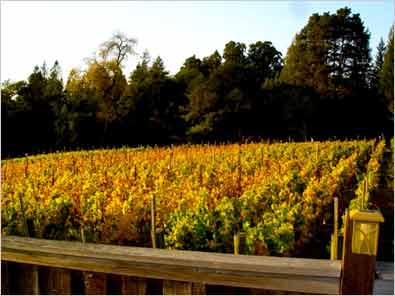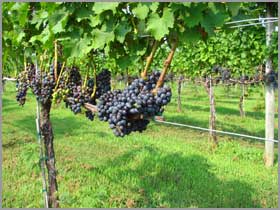
Meinklang vineyard scenes
Let’s be frank about this – the reason we drink wine isn’t just for what wine literati might call the lush aromas and fruity complexities.
Sure, those things are a big part of it. But the main reason I like wine is that it makes me feel good.
At lunch this past Friday, I discovered how to get an even better feeling out of it. I ordered an organic wine.
Knowing that the wine came from an earth-friendly vineyard somehow made it even more pleasurable.
Maybe it was because on that same day the Nobel Peace Prize was awarded for a green cause. Or maybe it was my body subtly telling me something on a deep level.
The wine was a 2006 Meinklang Pinot Noir from Austria, fuller and more darkly aromatic than most other Pinot Noirs I’ve had. My lunch companion seemed surprised and pleased by a Zinfandel richness.
The wine is made by the extended Michlits family on a mixed-agriculture farm using biodynamic principles, in the belief that “vital and robust grapes thriving in healthy, living soil bring exceptional wines of character.”
Biodynamic winegrowing techniques are free of synthetic pesticides and fertilizers. There’s admittedly also a strange mystical quality to some of the practices that followers say are aimed at promoting harmony with nature, like the one that calls for burying a cow horn filled with dung under the vineyard soil.
“Yet before you consign practitioners of biodynamics to the distant corner of your mind reserved for Shirley MacLaine and the weird sisters in ‘Macbeth,’ consider that among the people who practice biodynamic viticulture are some of the world’s great wine producers,” Eric Asimov observed in The New York Times a few years ago.
Not all organic wines are biodynamic. For that matter, not all U.S. wines made with organically grown grapes can be labeled “organic” if there’s been any sulfites added as a preservative, as this San Francisco Chronicle article explains in some detail.
In part because of those stringent labeling requirements, organic wines are still in the minority on wine store shelves in this country, but they have been steadily improving in quality even as they grow more popular and winemakers become more adept at organic methods.
“These eco-friendly wines, in many cases, have moved beyond their funky past,” according to this review by The Wall Street Journal’s Dorothy J. Gaiter and John Brecher. “They’re worth discovering.” Four of the dozen wines they describe in the article were under $15 when they bought them last year.
“Tides are certainly turning as more vintners are discovering that the common-sense approach to both organic and biodynamic growing methods results in not only ‘healthier’ vines, but in wines with greater flavor, more distinct terroir character and at times a noticeable cost-savings on their bottom line,” adds Stacy Slinkard, wine guide at About.com.
In the Cooking Up A Story video below, Dr. Robert Gross of Cooper Mountain Vineyards in Oregon gives a nicely illuminating account of why he runs an entirely organic operation.
While doing research for this article, I ran across a
Bon Appétit piece from earlier this year that offered as good an explanation as any on why that Meinklang Pinot Noir seemed so extra good to me. The explanation came from Mike Benziger of Sonoma’s
Benziger Family Winery.
“We’ve become so disconnected from the environment,” Benziger said. “When we taste a biodynamic wine, we’re able to make that connection back to nature, if only for an instant. And that’s powerful.”
It only seems right. The earth gives us this great gift. We should give something in return.



 Virginia’s Eastern Shore may not be the first place that comes to mind when you think about wineries. But it shouldn’t be the last, as I discovered during a recent getaway to Chincoteague and the
Virginia’s Eastern Shore may not be the first place that comes to mind when you think about wineries. But it shouldn’t be the last, as I discovered during a recent getaway to Chincoteague and the  Being a pioneer wasn’t easy. Many of the vines he imported from a California nursery had to be replaced a couple times, he says. His wife, Francesca, became pregnant (Angelica is five now and speaks the most delightful French). It became clear that another source of revenue had to be found. And thus was born the winery plan.
Being a pioneer wasn’t easy. Many of the vines he imported from a California nursery had to be replaced a couple times, he says. His wife, Francesca, became pregnant (Angelica is five now and speaks the most delightful French). It became clear that another source of revenue had to be found. And thus was born the winery plan.